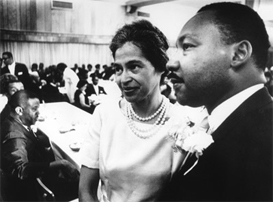We have heard his famous speech, seen the iconic images of the civil rights movement and are familiar with his struggle for democracy, justice, hope and love.
Today we feature a few, perhaps, little-known facts about Dr. King.
The Washington National Memorial for Martin Luther King Jr.
 |
Martin Luther King Jr. and Rosa Parks. |
- Lines from his famous speeches;
- Areas for reflection; and
- A nearly 30-foot “Stone of Hope” sculpture in his likeness.
The Martin Luther King Jr. memorial’s address is 1964 Independence Ave, SW, Washington, D.C. 20024. The street number is a reference to the Civil Rights Act of 1964, a milestone which Dr. King played an integral role in achieving. It also creates a “line of leadership” between the Lincoln Memorial (where he delivered the “I Have a Dream” speech) to the Jefferson Memorial.
The queen of the civil rights movement — Dorothy Height
As the phrase goes, “behind every great man is a great woman.”
Well, the woman behind Dr. Martin Luther King Jr. at his famous “I Have a Dream” speech was activist Dorothy Height. Height was the only woman in Dr. King’s inner circle — a group responsible for strategy, planning and action.
“He spoke longer than he was supposed to speak,” Height recalled in a 1997 Associated Press interview. But after he was done, it was clear King’s speech would echo for generations, she said, “because it gripped everybody.”
Height became president of the National Council of Negro Women in 1957 and held the post until 1997, when she was 85. Known for her sass and style, she died in 2010 at the age of 98.
The fight for a federal holiday
Just after Dr. King died, a bill was introduced to create a federal holiday in his honor.
However, it stalled in Congress for eight years. After that, it was argued that:
- It was too expensive to give a paid holiday to federal employees; and
- A holiday for a private citizen (who did not hold public office) would create precedence.
A public campaign that included a petition with six million signatures ultimately led Congress to pass the legislation with a veto-proof majority.
The first holiday was observed on the third Monday of January in 1986.